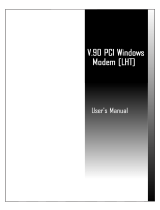
Compaq V.90 Integrated Modem Commands 3
ECG021/1298
Using Modem Commands
Entering a Command
Use the following guidelines when issuing modem commands:
• When using AT commands, start every command line (except the A/ and +++ commands)
with the attention (AT) code characters; otherwise, the modem will not execute the command.
• Type commands following the AT prefix in uppercase or lowercase letters or a combination
of both.
• Always type the AT prefix in the same case (not At or aT).
• Enter telephone numbers with or without punctuation; for example,
(123) 456-7890 or 1234567890
Editing and Executing a Command
If you make an error while typing a command, simply backspace over the mistake, then retype.
You cannot backspace over the AT prefix because it is interpreted immediately after it is typed.
To execute a command line, press the Enter key. (Pressing the Enter key tells the modem to
process the command line.)
Omitting a Parameter in a Command Line
If you enter a command that normally includes a numeric parameter, such as ATHn, without the
numeric parameter, the missing parameter is assumed to be the default parameter.
For example, the Hn (hang-up) command can have a numeric parameter of zero (H0), which is the
default, or of one (H1); however, if the parameter is missing, ATH plus the Enter key is the
equivalent of ATH0 plus the Enter key. This rule does not apply to the D (dial) command.
Repeating a Command
You can repeat the last command line issued by entering the A/ command. Because it also repeats
the AT prefix and the Enter key function, you are not required to enter the AT prefix or press the
Enter key when repeating this command.
The last command entered remains in the command buffer until the modem is reset or power to
the modem is turned off. Both actions clear the buffer and make the A/ command invalid since
there is no command for the modem to repeat.
Understanding Result Codes
A result code is the modem’s response to a command. It may be issued in either of two possible
formats: words (the long form, also known as verbose) or numeric characters (the short form,
represented by digits). The result code format is set using the Vn command:
• V1 for words (default)
• V0 for numeric characters




















